
When you’re writing a marketing story for engineers, this checklist can help you hit all the right notes to capture your reader’s interest. In this post I’ll break down how I wrote an article for ENGINEERING.com using this eleven-point list.
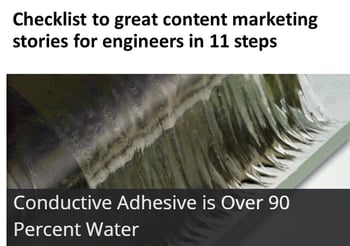 |
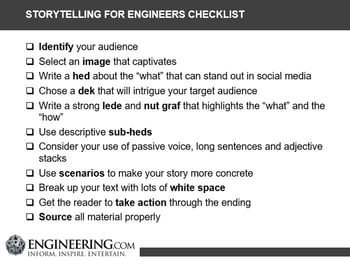 |
|
| See the full article here | Download the checklist here |
1. Identify your audience
This story is about an adhesive that was inspired by clams. We can expect two sorts of readers for this story: chemical engineers and engineers from other disciplines who have a general interest. This means that the story needs to be technical enough to hold the interest of the chemical engineers, but not so technical that the rest of the engineers and technicians struggle to understand it.
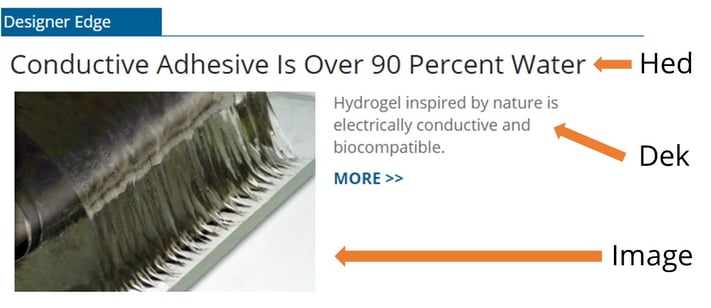
2. Select an image that captivates
I chose a picture from the MIT press release rather than a stock image. I thought that pictures from the actual experiments would be more likely to interest engineering professionals than a stock photo of a clam.
3. Write a hed about the “what” that can stand out in social media
The key phrase in the headline (or “hed”) of this article is “Over 90 Percent”. It’s impressive and stands out without being vague or hyperbolic. Engineers love numbers, so this works better than a more generic sentence like, “Conductive Adhesive is Almost Entirely Water”.
4. Choose a dek that will intrigue your target audience
Although the hed lacks technical jargon, the subheading (aka “dek”) includes the terms ‘hydrogel’ and ‘biocompatible’ in order to speak more directly to engineering professionals. The reference to the adhesive being inspired by nature without specifying the source of inspiration is intended to entice the reader further.
5. Write a strong lede and nut graf that highlights the “what” and the “how”
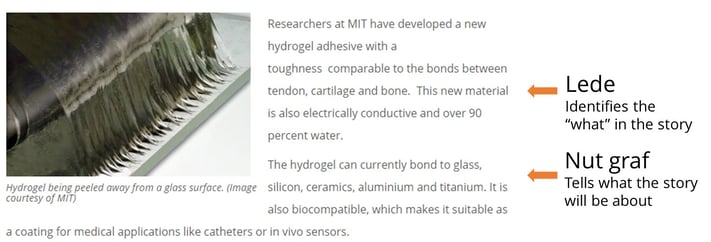
The “lede” is the first paragraph or two that hooks the reader while the “nut graf” is the paragraph that summarizes the rest of the story that will follow. The “what” here is the adhesive’s notable properties: it is electrically conductive and it’s 90 percent water. The “how” was more difficult to include, since the researchers didn’t disclose what they mixed with water to create their hydrogel. Fortunately, I had the option to include a video showing the hydrogel in action.
6. Use descriptive sub-heds
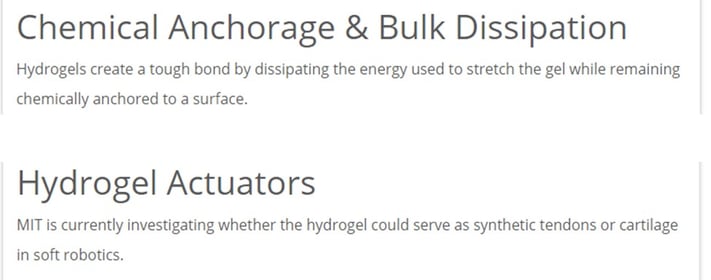
Good sub-headings allow the reader to grasp the main points of the article at a glance. The first sub-heading in the article identifies the two factors that determine hydrogel’s stickiness. The second cites a potential application for the adhesive the researchers are currently investigating.
7. Consider your use of passive voice, long sentences, and adjective stacks

Compare the sentence above with this one, which appeared in the first draft of the article:
“To create a tough and flexible bond, a hydrogel adhesive must be able to dissipate the energy used to stretch it while remaining chemically anchored to a surface.”
Although identical in content, the first sentence is much easier to read than the second.
8. Use scenarios to make your story more concrete
Add color and depth to your engineering content marketing with scenarios. In this case, the adhesive is still very much in the early stages of development, so there aren’t any commercial applications to reference. In order to make the story more concrete, I mentioned several potential applications including coatings for medical devices, actuators for robots and (per the technical editor’s suggestion) flexible solid batteries.
9. Break up your text with lots of white space

White space breaks your content into “brain-friendly” chunks. I broke up the text with the picture, video and two subheadings. I also separated some paragraphs to emphasize particular points, as with the last sentence below.
10. Get the reader to take action through the ending

Since this isn’t actually a marketing article, I didn’t ask the reader for a clear call to action. The best option in this instance was to direct readers to the website of the laboratory responsible for creating the adhesive. Shawn Fitzgerald, ThomasNet RPM, spoke on a joint webinar with us and gives some concrete examples of calls-to-actions that work for engineers. You can find it here.
11. Source all material properly

This last point should be a no-brainer, especially when writing for engineers.
Ian Wright is the newest member of the editorial team at ENGINEERING.com. Learn more about how to tell a good engineering story to generate leads here.





